Armories of the Hawaiʻi National Guard
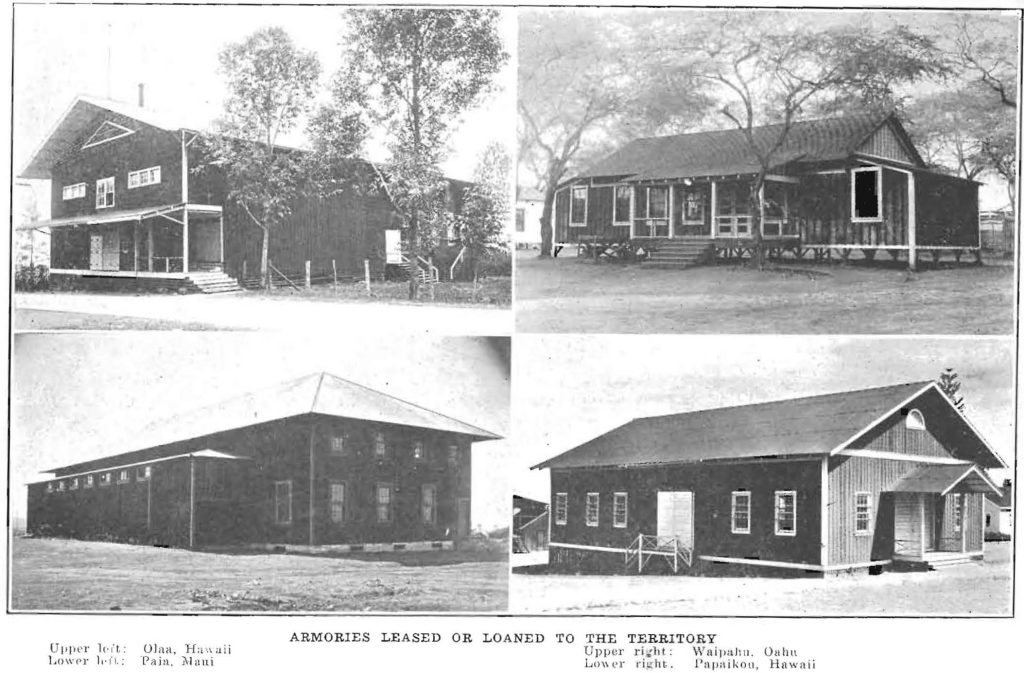
1885 – 01 FEB 1914 Drill Shed
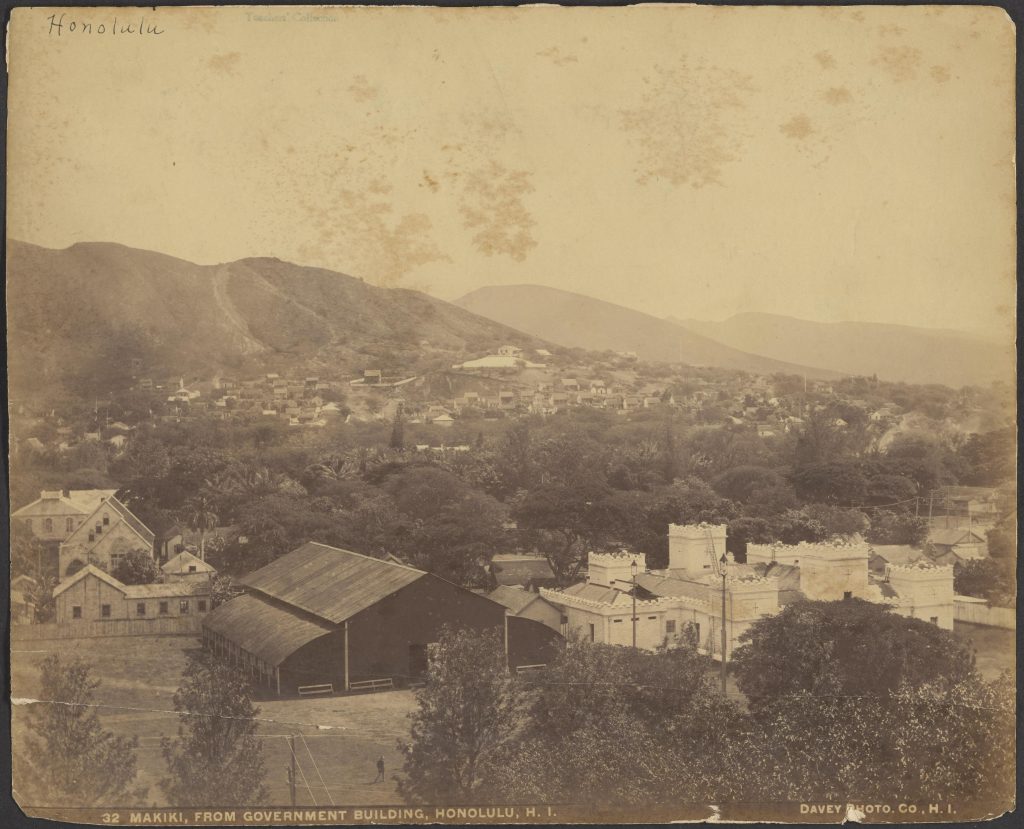

The pay of the soldiers was increased, and a Drill Shed constructed to house the battery of Austrian field pieces that Kalakaua had purchased during his trip around the world.
– History of the Hawaii National Guard pp. 20
The Drill Shed had been reconditioned for the use of the volunteers. For the use of the regulars, the old Iolani Barracks were completely overhauled, repainted and refurnished to make them into suitable living quarters. A kitchen was installed and outfitted so that the men might have their own mess. A bomb-proof powder magazine was constructed so that the National Guard would have a safe place in which to store its ammunition. Likewise a commissary was started and an Artificer enlisted to keep the arms in serviceable shape.
. . . A wooden floor was laid and electric lights installed in the Drill Shed so that the volunteers could drill at night. That was the only time the majority of them had available. Two more company rooms were also constructed, one for the artillery company and one for the old Royal Band which had offered its services to the new government.
– History of the Hawaii National Guard pp. 34
The most important drawback confronting the National Guard at this time was the lack of adequate armory facilities. . . At Honolulu the remainder of the regiment was quartered under four different roofs, none of them safe places for storing the new equipment. At Honolulu there was also no place where the men could drill at night or in rainy weather. The War Department informed the National Guard that it would be unable to grant it any further equipment unless it could provide a safe place for its storage.
In order to meet this situation the Territorial Legislature of 1903 appropriated $40,000 for the construction of armories; $5,000 for Hilo, $5,000 for Wailuku, and $30,000 for Honolulu. The armory at Hilo was constructed in 1904, but Honolulu and Wailuku allowed their appropriations to run out because of the failure to secure suitable sites. Difficulties were settled on Maui the following year and the armory constructed. However, the armory at Honolulu was not to become an actuality for over ten years. The site that the National Guard wanted for its new armory was occupied by the old Drill Shed, which had been built in 1885. It had been reconditioned in 1893 but was of cheap tin construction and was by now totally unsuited for housing equipment. Rain and dust blew through the sides and settled on the guns. The National Guard wished to tear down the Drill Shed and construct a modern armory on the site. However, the United States had taken over the Drill Shed and lot as government property in 1898 and still retained title to it. The National Guard made several attempts to have the site transferred back to the Territory but they proved unsuccessful. Rather than select a new site the National Guard decided to wait until it could get possession of the Drill Shed lot. There the matter stood until just before the World War.
– History of the Hawaii National Guard pp. 54-55
By 1908 the Krag-Jorgensen rifles issued to the National Guard had become unserviceable due to poor storage and had to be replaced by the Federal Government with new Springfield rifles. The War Department insisted that these rifles be given better care and suggested that the Adjutant General, Colonel John W. Jones, request the legislature to grant the National Guard sufficient funds to construct a proper storehouse. The legislature refused to appropriate any further money until the National Guard had secured a proper site for the construction of an armory. The main obstacle to this was the fact that the United States still held title to the Drill Shed lot, which was considered the most desirable site for a new armory.
Previous attempts had been made to have this lot returned to the Territory but the U.S. government was unwilling to give it up until other provisions had been made for its own troops. By this time, however, Fort Shafter, Fort Ruger, Fort De Russy and Fort Armstrong had been constructed and the United States signified its willingness to return the lot to the Territory provided that the legislature would guarantee to appropriate enough money to construct an armory on it. The Legislature of 1910 debated at great length on this subject but finally agreed to appropriate $100,000 for the construction of a new armory at Honolulu. The money was to become available on July 1, 1912, and on March 27th of that year President Taft transferred the Drill Shed lot back to the Territory in an executive order. Construction was commenced on the armory in the latter part of the year.
– History of the Hawaii National Guard pp. 61
01 FEB 1914- ? Honolulu Armory
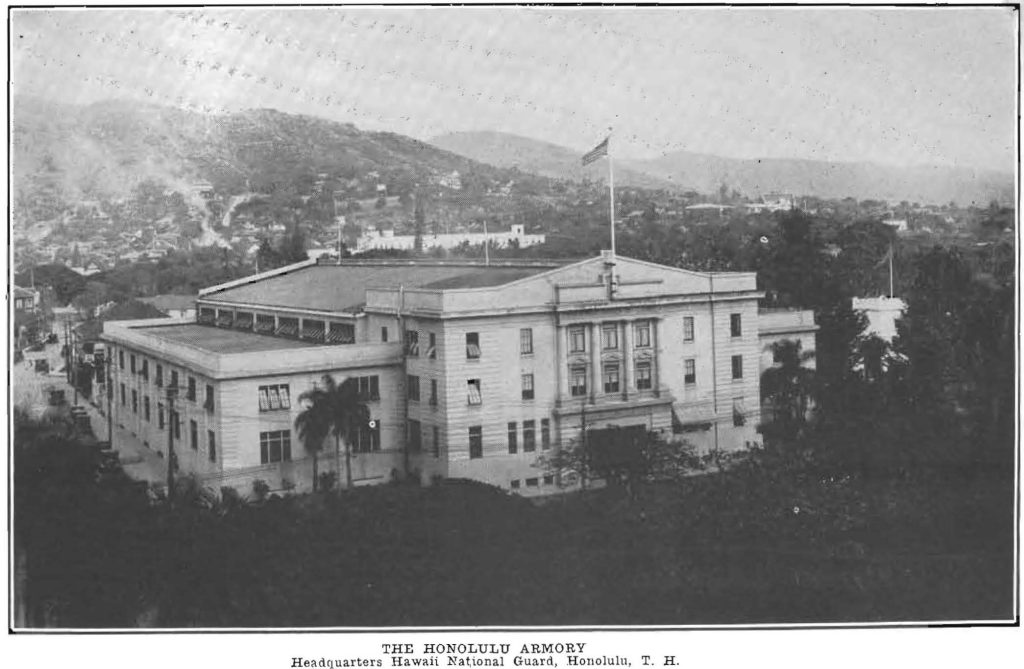

Previous attempts had been made to have this lot returned to the Territory but the U.S. government was unwilling to give it up until other provisions had been made for its own troops. By this time, however, Fort Shafter, Fort Ruger, Fort De Russy and Fort Armstrong had been constructed and the United States signified its willingness to return the lot to the Territory provided that the legislature would guarantee to appropriate enough money to construct an armory on it. The Legislature of 1910 debated at great length on this subject but finally agreed to appropriate $100,000 for the construction of a new armory at Honolulu. The money was to become available on July 1, 1912, and on March 27th of that year President Taft transferred the Drill Shed lot back to the Territory in an executive order. Construction was commenced on the armory in the latter part of the year.
– History of the Hawaii National Guard pp. 61
The armory at Honolulu was accepted on February 1, 1914, although it was not completed. It was discovered that the original appropriation of $100,000 was not sufficient to cover the cost of adequately equipping the armory and an additional appropriation of $40,000 was asked. The Legislature of 1915 dubiously granted this request and the armory was finally finished.
– History of the Hawaii National Guard pp. 61
The armory facilities of the National Guard are not quite adequate at present but for the most part constructed so that the equipment stored in them does not too greatly deteriorate from the salt air and humidity. . . The Territory now has three excellent, permanent armories; two at Honolulu (Honolulu Armory and Iolani Barracks) and the other at Hilo, Hawaii (Hilo Armory).
– History of the Hawaii National Guard pp. 95
The last legislature made appropriations for armories in the Loan Fund, $100,000.00 being appropriated for an armory in Honolulu and $10,000.00 for an armory at Lahaina, Maui. The firm of Ripley & Davis, architects were employed to prepare plans for the armory at Honolulu and submitted very satisfactory and complete plans, similar in detail to the armories in Denver Colorado and Los Angeles, California, and which, with the changed conditions imposed by the War Department, afford every facility for the care, storage and safety of property, in order that the War Department, the Territory and the responsible and accountable officers, particularly the bonded officers, may be protected and safeguarded in every respect.
The following communication presents a brief statement of the facts contained in many letters and reports, leading up to the return to the Territory of the ”Drill Shed or Barracks Lot.”
– 1911-1912 Biennial Report pp.63
Bids for the new armory at Honolulu were opened January 18 and the contract signed on January 22nd and actual work has commenced and now the guardsmen who have been constant in their efforts’ to keep the Guard together begin to feel that they will see the realization of the hope to which they have been so steadfast and to which they have given so much of their time in the past.
The interior of the armory cannot be entirely completed within the present appropriation and will require approximately $30,000 to complete it. . .
During the construction of the armory at Honolulu the companies have been temporarily quartered in the Shooting Gallery which was moved on to the site facing Beretania street.
– 1911-1912 Biennial Report pp. 67-69
Honolulu, Oahu-Three. Honolulu Armory, main construction concrete, in good condition. Erected in 1915. Renovated in 1936.
– 1936-1937 Annual Report pp.17
Iolani Barracks
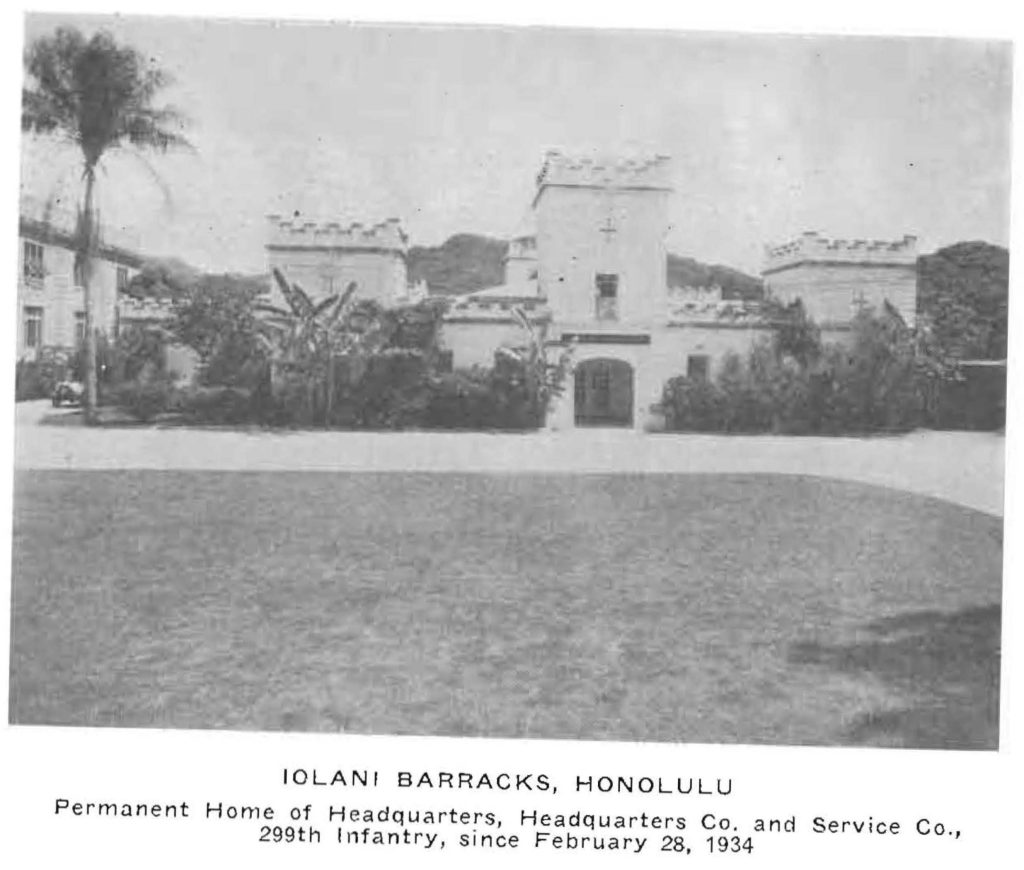
The oldest armory in the Territory is Iolani Barracks, adjoining the Honolulu Armory. This medieval-appearing structure which resembles a miniature fortress-castle of some European State, was built in the early 1870’s to house the Royal Household Guards, whose duties were to act as sentries, guards of honor and the like to his Majesty, the King. The building was occupied late in the reign of Kamehameha V and continued as a Royal Barracks through the reigns of Lunalilo, Kalakaua and Liliuokalani, up to January 17, 1893. The building and grounds were placed in the custody of the United States Army through Executive Order of the President, dated December 19, 1899. On January 19, 1931, the Commanding General, Hawaiian Department, United States Army, granted permission for the Territory to take possession of the Barracks pending receipt of the Presidential Executive Order granting its return to the Territory. It was occupied by the Department of Public Instruction until it was conveyed to the Military Department of the Territory by Executive Order No. 613 of the Governor of Hawaii, dated February 28, 1934.
– History of the Hawaii National Guard pp. 95
For the use of the regulars, the old Iolani Barracks were completely overhauled, repainted and refurnished to make them into suitable living quarters. A kitchen was installed and outfitted so that the men might have their own mess.
– History of the Hawaii National Guard pp. 34
The armory facilities of the National Guard are not quite adequate at present but for the most part constructed so that the equipment stored in them does not too greatly deteriorate from the salt air and humidity. . . The Territory now has three excellent, permanent armories; two at Honolulu (Honolulu Armory and Iolani Barracks) and the other at Hilo, Hawaii (Hilo Armory).
– History of the Hawaii National Guard pp. 95
20 JUN 1958 – ? Wahiawa Armory

Armory: Two armory construction projects were completed in Fiscal Year 1958 under the provisions of Public Law 783, 81st Congress, which provides for Federal support of essential armory construction. A single unit armory at Kahului, Maui, was completed and accepted on 5 November 1957. Total cost of the project was $139,292.00 of which amount the Federal Government paid $92,193.00 and the Territory of Hawaii $47,099.00. This armory furnishes facilities for Company C of the 299th Regimental Combat Team. A three-unit armory at Wahiawa, Oahu, to house three units of the 297th AntiAircraft Artillery Battalion was completed and accepted on 20 June 1958. Total cost of this project was $251,656.24 of which the Federal Government furnished $173,129.79 and the Territory of Hawaii share was $78,526.45.
– 1958 Annual Report pp.14
12 APR 1962 – ? Diamond Head Crater Armory
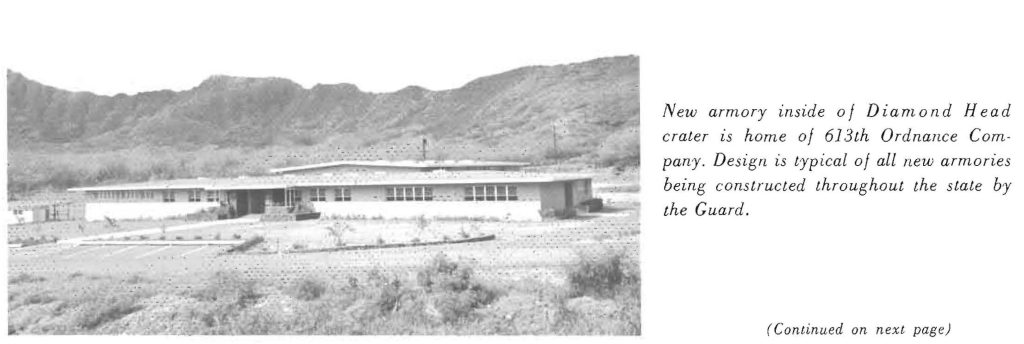
One new armory was completed and a second one was placed under contract during Fiscal Year 1962. A new one-unit armory on the interior of Diamond Head Crater was completed and accepted on 12 April 1962. This armory will house the 613th Ordnance Company (Direct Support) of the Hawaii Army National Guard. Cost of the new armory was $189,000.00 of which the Federal share was $115,000.00 and the State paid $74,000.00. Location of the new armory ties in with the overall master plan for the Fort Ruger area and places it in close proximity to the proposed location of the new Combined Field Maintenance Shop which is scheduled to be constructed in Diamond Head Crater during Fiscal Year 1963.
– 1962 Annual Report
1904 – ? Hilo Armory
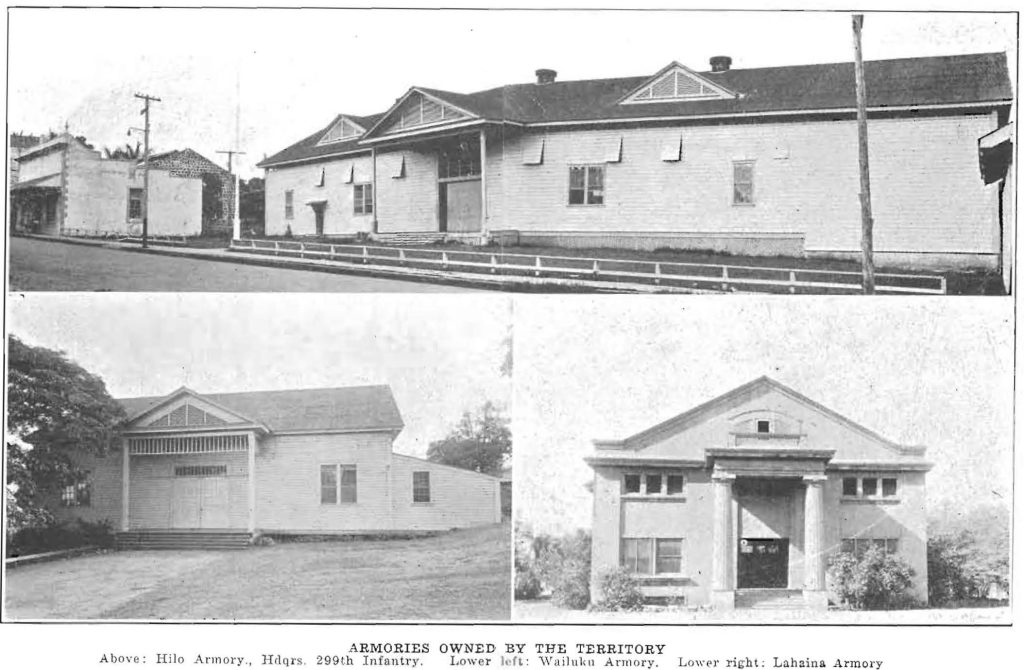
The most important drawback confronting the National Guard at this time was the lack of adequate armory facilities. Company D at Hilo was compelled to rent a building for its use at considerable expense. . . .
In order to meet this situation the Territorial Legislature of 1903 appropriated $40,000 for the construction of armories; $5,000 for Hilo, $5,000 for Wailuku, and $30,000 for Honolulu. The armory at Hilo was constructed in 1904, but Honolulu and Wailuku allowed their appropriations to run out because of the failure to secure suitable sites.
– History of the Hawaii National Guard pp. 54-55
The Armory at Hilo is in good condition, just having had general repairing done at an approximate cost of 650.00. The plumbing of this building should be attended to, and will require an expenditure of approximately $100.00.
– 1911-1912 Biennial Report pp. 67-69
25 NOV 1931 rebuilt

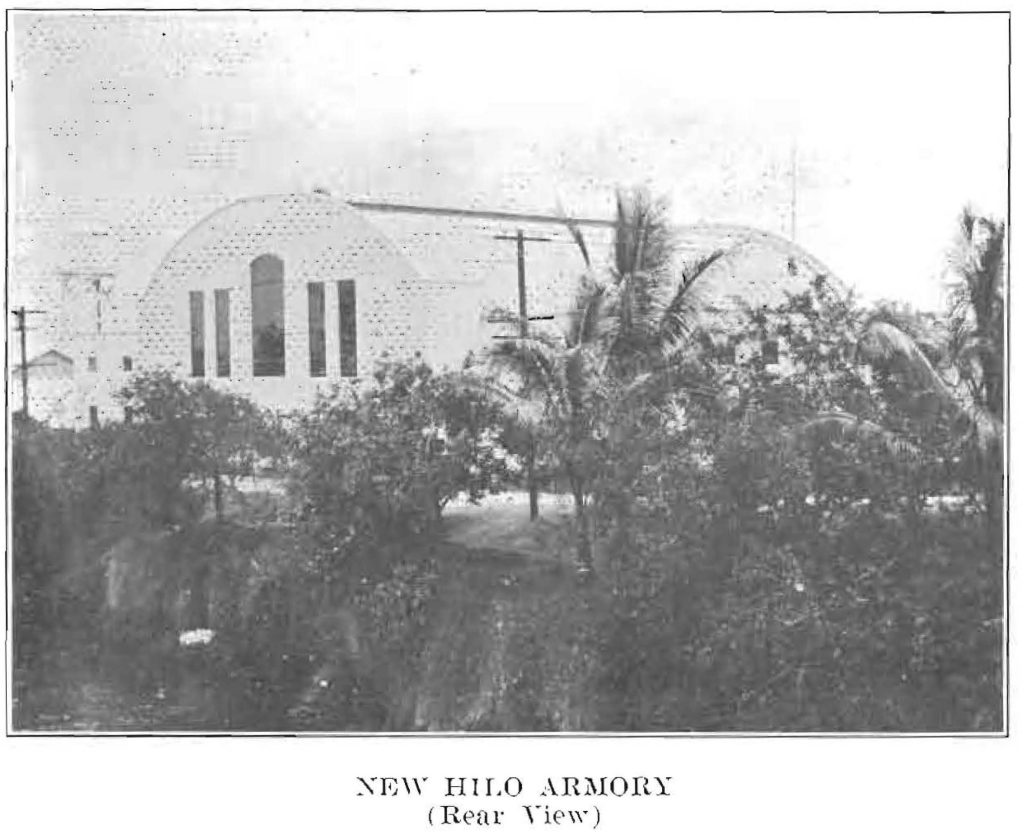
The armory facilities of the National Guard are not quite adequate at present but for the most part constructed so that the equipment stored in them does not too greatly deteriorate from the salt air and humidity. In 1931 a new armory was built at Hilo, Hawaii, at an initial cost of $85,000. It is constructed out of concrete and hollow tile and is complete in every way.
– History of the Hawaii National Guard pp. 95
Item 14, Act 243, Session Laws, 1929, appropriated $85,000.00 for a new National Guard Armory for the City of Hilo, Hawaii, and this should be built at an early date to replace the old and dilapidated one at present in that city.
– 1928-1929 Annual Report pp. 16
The New Hilo Armory, built at an initial cost of $85,000.00, is distinctly a credit to the Territory and to the City of Hilo. It is quite likely that this armory will be the center of much non-military activity in that city, although the military use shall alway have precedence over any other uses.
–1930-1931 Annual Report pp.45
Honomu Armory

The armory facilities of the National Guard are not quite adequate at present but for the most part constructed so that the equipment stored in them does not too greatly deteriorate from the salt air and humidity. . . In addition to this it has one frame armory in fair condition at Honomu, Hawaii (Honomu Armory) and two very old and dilapidated ones, one at Lahaina (Lahaina Armory) and one at ‘Wailuku (Wailuku Armory), Maui.
– History of the Hawaii National Guard pp. 95
Honomu, Hawaii – One Main construction frame, In fair condition. Fire occurred in this armory during the month of June, 1934
– 1934-1935 Annual Report pp.21
Kohala Armory

1905- ? Wailuku Armory

The most important drawback confronting the National Guard at this time was the lack of adequate armory facilities. Company D at Hilo was compelled to rent a building for its use at considerable expense. Company I at Wailuku, Maui, had to use the Police Station for meeting and the storing of its arms and ammunition. . . .
In order to meet this situation the Territorial Legislature of 1903 appropriated $40,000 for the construction of armories; $5,000 for Hilo, $5,000 for Wailuku, and $30,000 for Honolulu. The armory at Hilo was constructed in 1904, but Honolulu and Wailuku allowed their appropriations to run out because of the failure to secure suitable sites. Difficulties were settled on Maui the following year and the armory constructed.
– History of the Hawaii National Guard pp. 54-55
In December, 1914, a concrete storage room was finished at Wailuku, Maui, and was used to house the arms that formerly had been kept at the police station. All organizations of the National Guard of Hawaii were now well housed and equipped and the force immediately assumed a new aspect.
– History of the Hawaii National Guard pp. 61
The armory facilities of the National Guard are not quite adequate at present but for the most part constructed so that the equipment stored in them does not too greatly deteriorate from the salt air and humidity. . . In addition to this it has one frame armory in fair condition at Honomu, Hawaii (Honomu Armory) and two very old and dilapidated ones, one at Lahaina (Lahaina Armory) and one at ‘Wailuku (Wailuku Armory), Maui.
– History of the Hawaii National Guard pp. 95
As the result of all this publicity and activity, the 18th Session of the Territorial Legislature seemed favorably inclined toward the Military Department of the Territory, appropriating the sum of $81,906.52 for its support for the two-year period July I, 1935-June 30, 1937. Of this sum $16,200 was for repairs to buildings. In addition, $50,000 was appropriated under the control of the Superintendent of Public Works for the construction of a new armory at Wailuku.
– History of the Hawaii National Guard pp. 98
The Armory at Wailuku is greatly in need of painting general repairing and the installation of storage rooms lockers for the proper care and safeguarding of property. sum of $1500.00 is required for this purpose, as one of the age rooms should be of reinforced concrete.
– 1911-1912 Biennial Report pp. 67-69
04 DEC 1937 Rebuilt
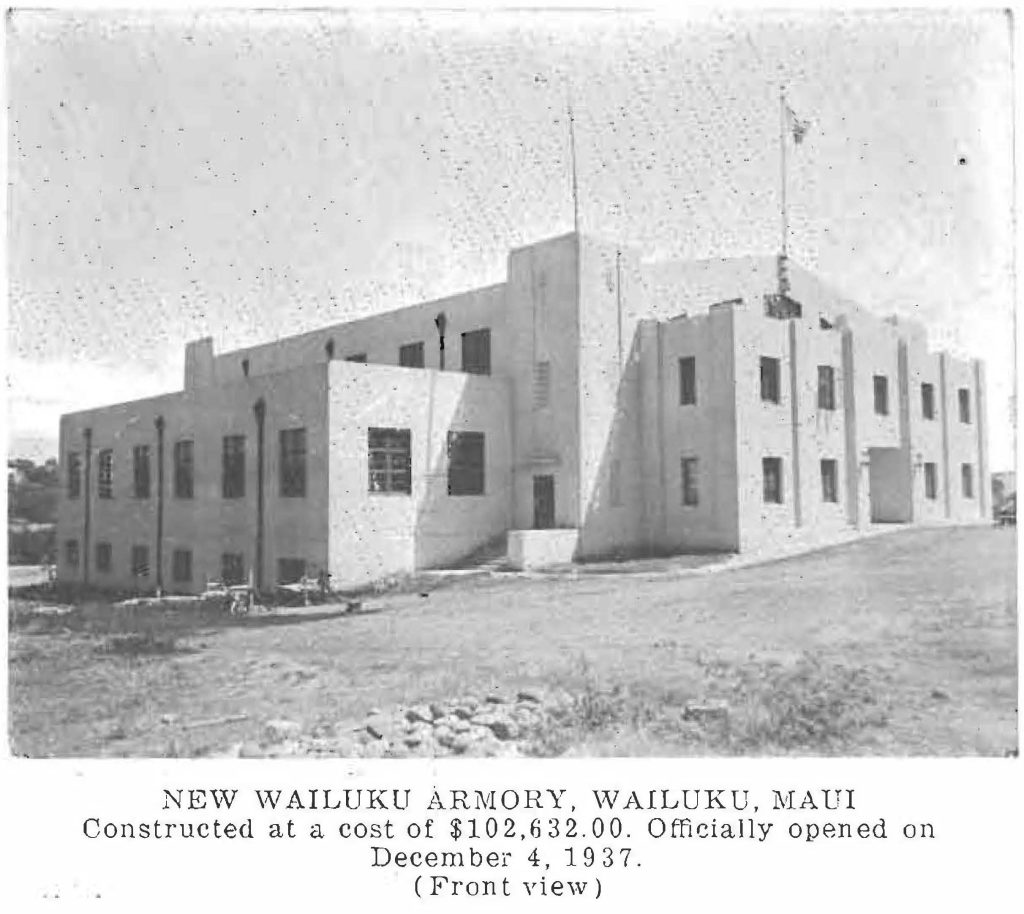
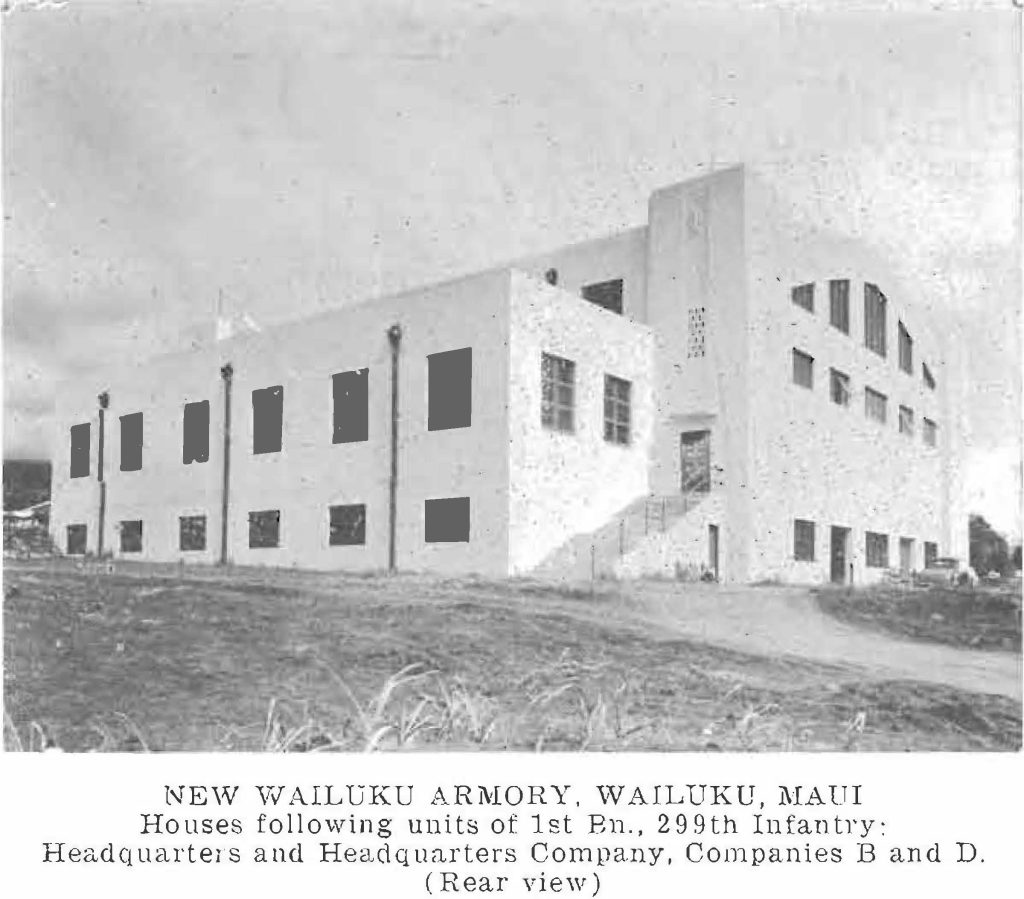
The new Wailuku Armory, Wailuku, Maui, constructed at a cost of $102,632.00, was officially opened on December 4, 1937. It houses the following units of the 1st Bn., 299th Infantry: Headquarters and Headquarters Company, Companies B and D. The plan of the building is as follows:
–1937-1938 Annual Report pp. 17
- Basement Floor: Area 17,456 sq. ft. with 3 locker rooms, 3 supply rooms, 2 storage rooms, 3 strong rooms, 1 magazine room, rifle range and toilets. Height of basement floor to 1st floor ceiling 11′-0. Ample room so that trucks can drive into building. Present basement (under main hall) has no concrete floor.
- First Floor: Area 17,308 sq. ft. -Consists of 2 offices, 1 assembly room, 3 company rooms and main drill hall, 95′-0 x 700′-0, kitchen and rest room.
- Second Floor: 2 Balconies, one on each side of hall, and office quarters. Total area 2nd floor, including balconies, ls 4,609 sq. ft.
- Structure: Main hall floor of wood, supported by structural steel frames. Main trusses of steel supported by steel columns. All roof of wood sheeting covered with felt roofing. The two wings and the front office portion of concrete skeleton with wood joists and flooring. All outside wall of hollow concrete tile plastered outside.
14 AUG 1913 – ? Lahaina Armory

At the same time $10,000 had been appropriated for the construction of a new armory at Lahaina, Maui. It was completed and accepted on August 14, 1913.
– History of the Hawaii National Guard pp. 61
The armory facilities of the National Guard are not quite adequate at present but for the most part constructed so that the equipment stored in them does not too greatly deteriorate from the salt air and humidity. . . In addition to this it has one frame armory in fair condition at Honomu, Hawaii (Honomu Armory) and two very old and dilapidated ones, one at Lahaina (Lahaina Armory) and one at ‘Wailuku (Wailuku Armory), Maui.
– History of the Hawaii National Guard pp. 95
Plans were prepared by the Department of Public Works and proposals for building the armory at Lahaina were Opened and the contract awarded February 17th, and it is hoped that with its erection the company at Lahaina will be brought to a high state of efficiency.
– 1911-1912 Biennial Report pp. 67-69
Lihue Armory
The recent session of the Territorial Legislature appropriated $5,500.00 for a new one-company armory to be erected at Lihue, Kauai. Work on this new armory should commence about January, 1926.
– 1924-1925 Annual Report pp. 7
10 MAR 1939 Rebuilt
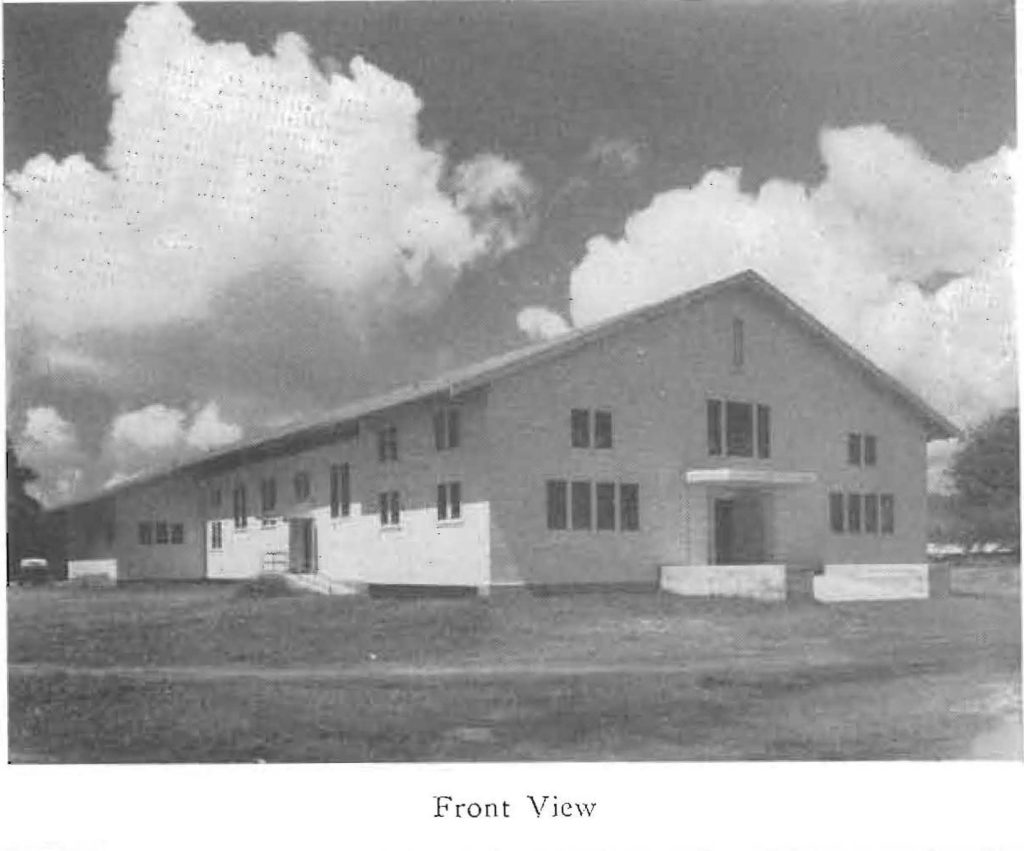

? -28 OCT 1925 Kapaa Armory
The frame, one-company, armory at Kapaa, Kauai, was donated to the Territorial Board of Health on October 28, 1925.
– 1925-1926 Biennal Report pp. 20
10 MAR 1939 – ? Hanapepe Armory
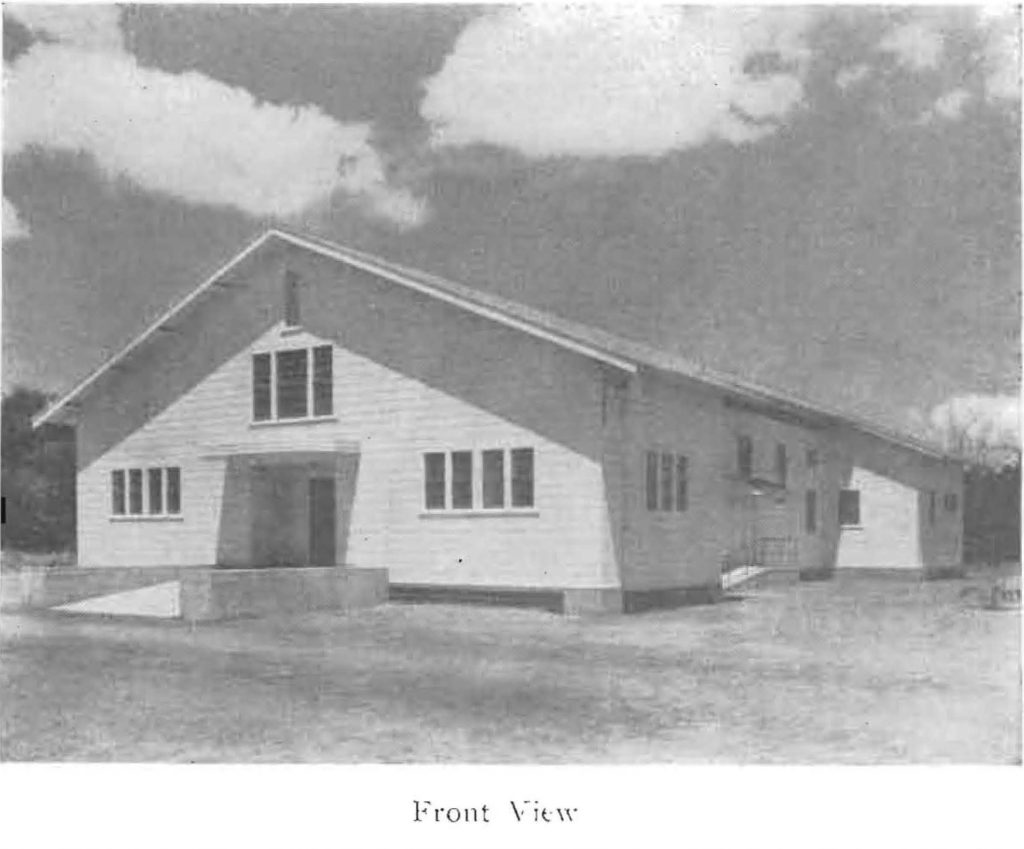
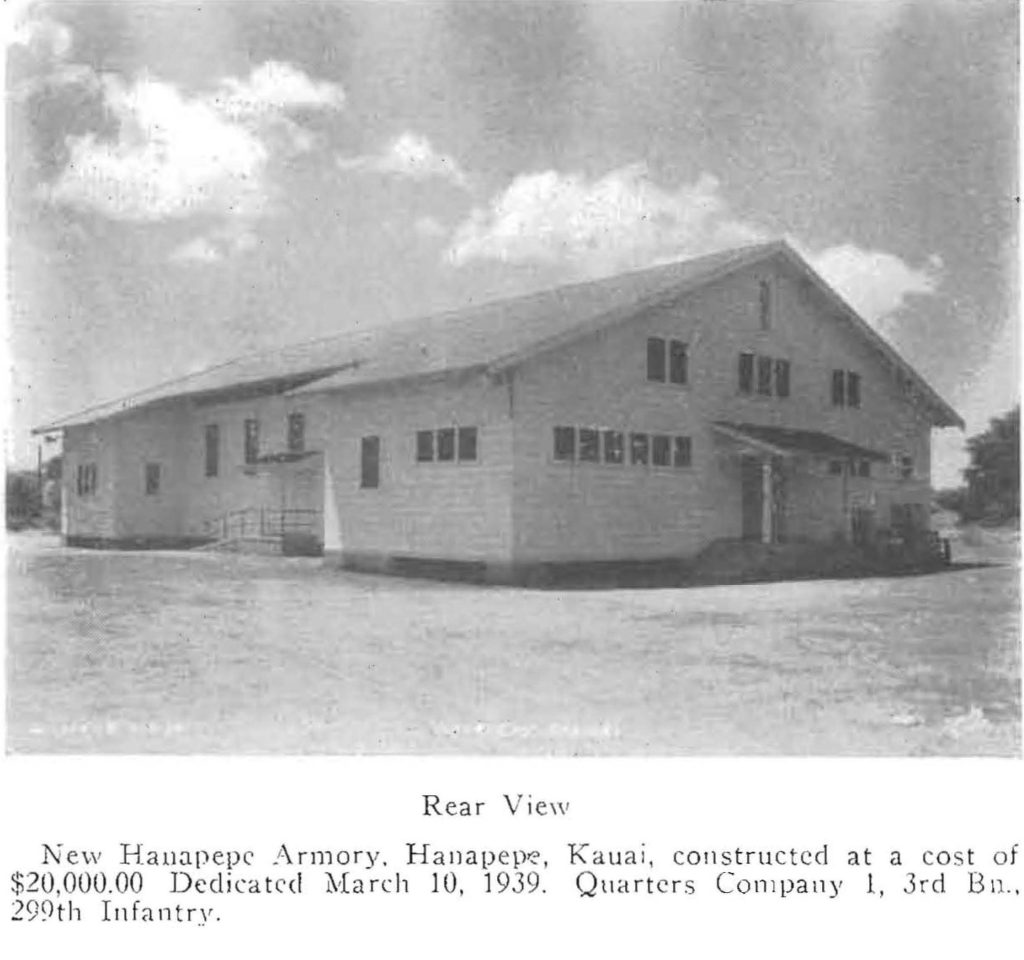
05 MAR 1939 – ? Kaunakakai Armory
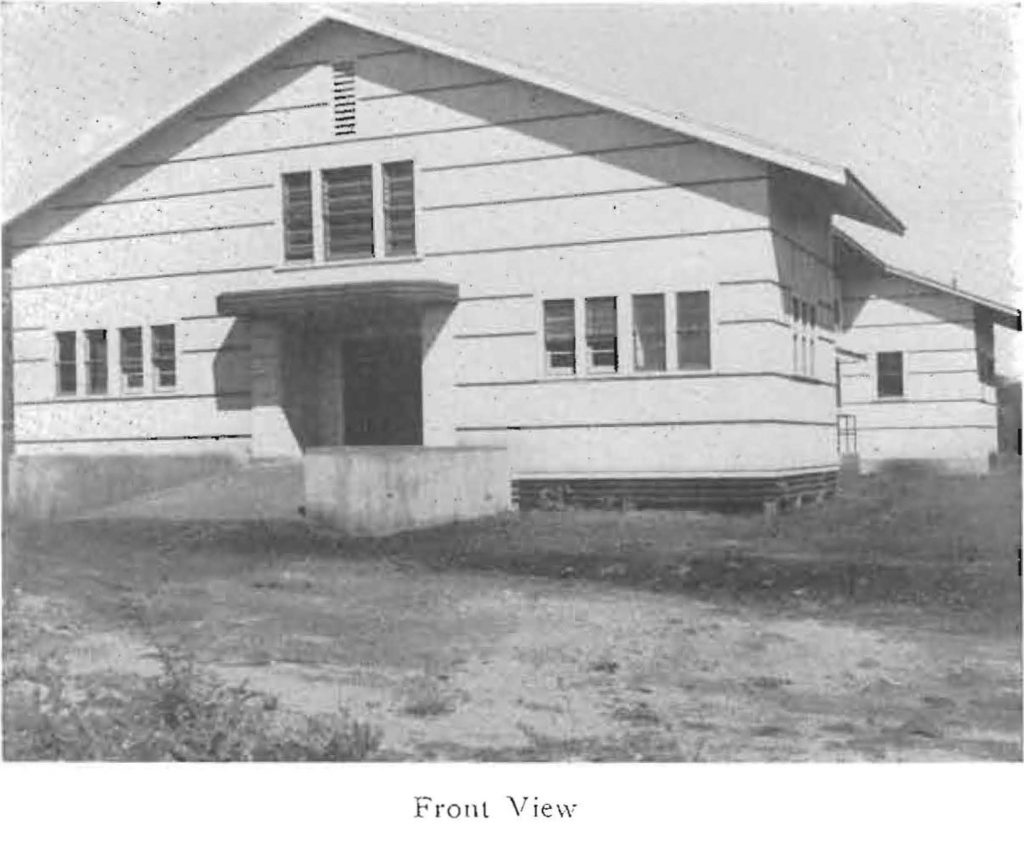
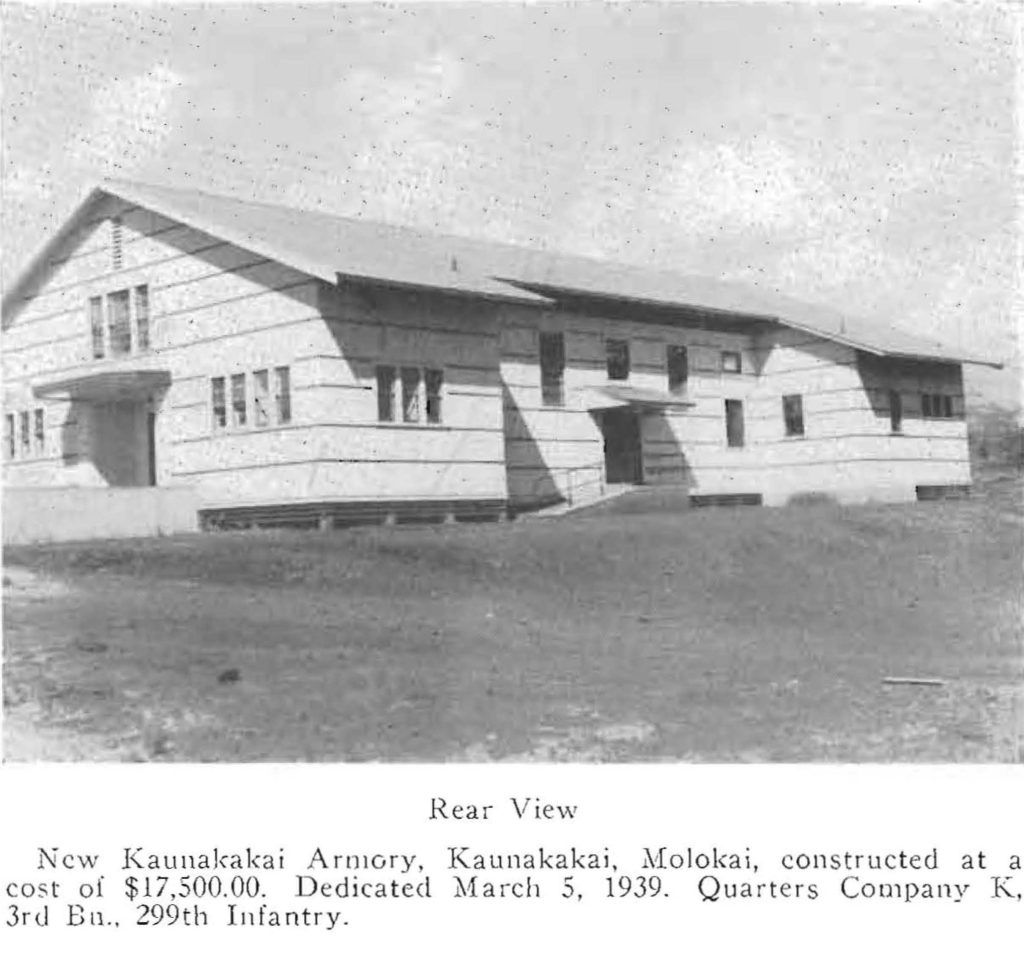
28 MAY 1965 – ? Honokaa Armory
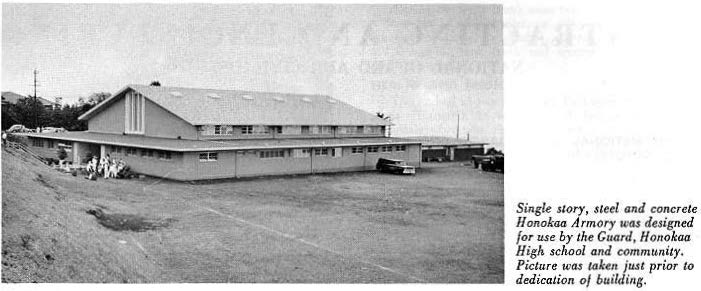
A new one-unit armory building located on the grounds of the Honokaa High School, Honokaa, Hawaii, was completed and accepted on 28 May 1965. The building is a single story masonry structure of modern functional design containing approximately 16,600 sq. ft. of floor space, and will provide armory facilities for Company C, 2nd Battalion, 299th lnfantry, Hawaii Army National Guard. A unique feature of the building is that it is designed as a combination armory and gymnasium containing a hardwood playing floor, equipment for basketball and volleyball, and folding bleachers with a scaling capacity of approximately 1,000. The building will be utilized not only as an armory but as a gymnasium by the Honokaa High School and the Honokaa community. Total cost of this project was $283,730.00, supported by Federal funds in the amount of $126,678.00, and State funds in the amount of $157,052.00.
– 1965 Annual Report pp.19
